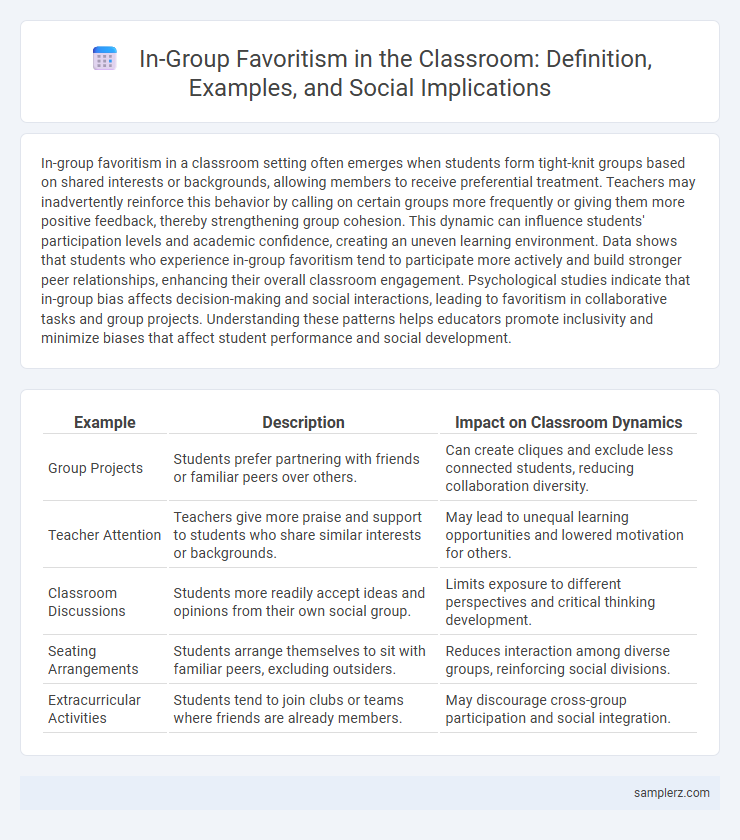In-group favoritism in a classroom setting often emerges when students form tight-knit groups based on shared interests or backgrounds, allowing members to receive preferential treatment. Teachers may inadvertently reinforce this behavior by calling on certain groups more frequently or giving them more positive feedback, thereby strengthening group cohesion. This dynamic can influence students' participation levels and academic confidence, creating an uneven learning environment. Data shows that students who experience in-group favoritism tend to participate more actively and build stronger peer relationships, enhancing their overall classroom engagement. Psychological studies indicate that in-group bias affects decision-making and social interactions, leading to favoritism in collaborative tasks and group projects. Understanding these patterns helps educators promote inclusivity and minimize biases that affect student performance and social development.
Table of Comparison
| Example | Description | Impact on Classroom Dynamics |
|---|---|---|
| Group Projects | Students prefer partnering with friends or familiar peers over others. | Can create cliques and exclude less connected students, reducing collaboration diversity. |
| Teacher Attention | Teachers give more praise and support to students who share similar interests or backgrounds. | May lead to unequal learning opportunities and lowered motivation for others. |
| Classroom Discussions | Students more readily accept ideas and opinions from their own social group. | Limits exposure to different perspectives and critical thinking development. |
| Seating Arrangements | Students arrange themselves to sit with familiar peers, excluding outsiders. | Reduces interaction among diverse groups, reinforcing social divisions. |
| Extracurricular Activities | Students tend to join clubs or teams where friends are already members. | May discourage cross-group participation and social integration. |
Understanding In-Group Favoritism in Classroom Dynamics
In-group favoritism in classroom dynamics often manifests when students preferentially collaborate with peers who share similar backgrounds, interests, or social identities, fostering stronger bonds within their group. This behavior influences participation, resource sharing, and support during group assignments, subsequently impacting academic performance and social cohesion. Recognizing these patterns helps educators design inclusive activities that promote equitable interaction among diverse student groups.
Teacher's Preferential Treatment Towards Certain Student Groups
Teacher's preferential treatment towards certain student groups often manifests through giving more attention, positive feedback, and higher expectations to students perceived as part of the teacher's in-group, such as those sharing similar cultural backgrounds or higher academic performance. This favoritism can reinforce social hierarchies, leading to unequal participation and opportunities among students. Research in educational psychology highlights that in-group favoritism by teachers impacts classroom dynamics, affecting student motivation and academic self-concept.
Peer Group Cliques and Their Effects on Classroom Inclusion
Peer group cliques in classrooms often exhibit in-group favoritism by selectively including members who share similar interests or backgrounds, resulting in exclusion of others. This dynamic reinforces social hierarchies and limits interactions across diverse student groups, impacting overall classroom inclusion. Teachers can mitigate these effects by promoting cooperative learning activities that encourage collaboration among different peer groups.
Group Assignment Bias: Rewarding Friends Over Merit
In classroom group assignments, in-group favoritism often manifests as rewarding friends over merit, where students preferentially allocate higher grades or leadership roles to peers within their social circle. This bias undermines fair evaluation by prioritizing personal relationships instead of individual contributions or competence. Such behavior reinforces social cliques and diminishes motivation among non-favored group members, impacting overall classroom dynamics and equity.
Language-Based In-Group Favoritism Among Students
Language-based in-group favoritism among students manifests when peers preferentially collaborate or socialize with classmates who share the same native language, enhancing trust and group cohesion. Studies show this behavior can lead to exclusion of non-native speakers, affecting classroom dynamics and academic participation. Such favoritism emphasizes the importance of inclusive language policies and intercultural competence development in educational settings.
Club Memberships Creating Classroom Divides
Club memberships often create visible in-group favoritism in classrooms, where students belonging to popular clubs receive more attention and social support from peers and teachers. This division fosters exclusive social circles that often marginalize non-members, impacting classroom dynamics and collaboration. Research shows that students in prominent clubs tend to have higher social status and are more likely to receive positive reinforcement, reinforcing social hierarchies.
Socioeconomic Status and Friendship Circles in Learning Environments
In classroom settings, in-group favoritism often manifests through students preferring peers from similar socioeconomic backgrounds, reinforcing exclusive friendship circles that align with shared financial resources and cultural capital. These dynamics influence group work and social interactions, as students within higher socioeconomic status groups tend to access better learning opportunities and collaborative support. Teachers may observe that such favoritism can perpetuate inequality, affecting participation and academic achievement across diverse student groups.
Cultural Similarities Influencing Group Work Preferences
Students in classrooms often display in-group favoritism by preferring to collaborate with peers who share similar cultural backgrounds, enhancing communication and mutual understanding during group projects. This preference can lead to more cohesive and efficient teamwork, as cultural similarities influence work styles, values, and conflict resolution approaches. Such dynamics illustrate how cultural affinity shapes group work preferences and impacts social interactions within educational environments.
Boys vs. Girls: Gender-Based In-Group Favoritism in Activities
Boys in the classroom often show in-group favoritism by forming teams exclusively with other boys during competitive activities, reinforcing gender-based group boundaries. Girls similarly tend to support and collaborate more readily with other girls, creating distinct social clusters that influence participation and cooperation. These gender-based preferences can impact group dynamics, academic performance, and social development within educational settings.
Lunch Table Segregation: Social Groupings in the School Setting
Lunch table segregation in classrooms exemplifies in-group favoritism, where students preferentially sit with peers who share similar interests, backgrounds, or social identities. These social groupings reinforce group cohesion and exclusion of outsiders, impacting social dynamics and peer relationships. Such segregation often influences students' sense of belonging and academic collaboration within the school environment.

example of in-group favoritism in classroom Infographic
 samplerz.com
samplerz.com